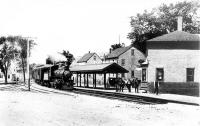
Quarry, State Prison, Thomaston, Maine c 1870
Thomaston Historical Society
Throughout the years, work industries programs for prison inmates were expanded. At first, the quarry was the main source of labor that provided income to help defray the cost of keeping a prisoner fed and clothed. A woodworking shop was added, in which prisoners were taught how to build wooden wagons, buckboards, buggies and sleighs. This led to the production of harnesses and tack for horses.

Prison Brooms to the Train Depot, Thomaston, 1915
Thomaston Historical Society
A broom factory was established at the prison and in 1899, a newspaper reports that railroad carloads of broomcorn, ash lumber from Bangor and broom handles were received. The completed brooms were transported by wagon back to the railroad depot on Knox Street for shipment to various sales outlets.

Railroad Depot, Thomaston, Maine c 1871
Thomaston Historical Society
Other industries throughout the years have included upholstery and the production of vehicle license plates. Inmates worked in gardens, first at a location adjoining the prison, and later on land leased from nearby farms. Surplus produce was shipped via rail to Augusta for use in other state institutions. This led to the purchase of a prison farm in nearby Warren, run entirely by prison labor. The Bolduc Correctional Facility on Route 97 is still an active farm industry for inmates.

Prison Corner, Thomaston, ca. 1871
Thomaston Historical Society
The prison initiated a highly successful program of constructing furniture. In the 1930s the line was expanded to include crafts and novelty items. The Carr O’Brien brick building on the opposite corner of Wadsworth Street and Route One, directly adjacent to the prison grounds, was built in 1852 as a bank. In 1957 the Maine State Prison purchased the building for use as an outlet for products built by the inmates. The Prison Showroom on Route One at this location remains a thriving commercial business.
<- Prev. Page .................... Next Page ->